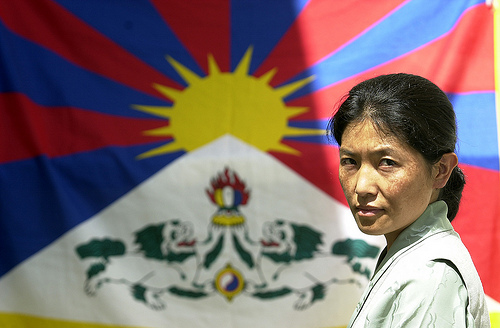Ngawang Sangdrol is a human rights activist who came to speak at URI about her work fighting for freedom. PHOTO CREDIT: gwarlingo.com
The University of Rhode Island’s Center for Nonviolence and Peace Studies’ ongoing lecture series has given international human rights activists a platform to share their stories of fighting for peace through nonviolence.
Last week’s lecture, entitled “Nonviolent Resistance: Tibetan Freedom Struggle,” featured human rights activist and former political prisoner Ngawang Sangdrol. Sangdrol discussed her experiences with restricted freedoms and her motivation behind peaceful protesting in Tibet in order to bring awareness to the country’s continuous struggle for freedom.
Sangdrol began protesting against the Chinese Communist Party’s (CCP) oppression in Tibet at age 10 and has since then been a “beacon of nonviolent resistance,” according to the lecture flier. In addition to sharing her story, she continues to protest CCP persecution as a human rights analyst for the International Campaign for Tibet.
When she was imprisoned by CCP authorities at the age of 13, Sangdrol became one of the youngest people convicted during the Tibetan freedom struggle. She also currently holds the title of “longest serving Tibetan female political prisoner,” according to the International Campaign for Tibet.
Since the CCP took over the country of Tibet in 1949, over 1.2 million Tibetans have been killed, and thousands more have been imprisoned, according to Sangdrol. Any expression of Tibetan culture, such as owning Tibetan booklets and songs or practicing Tibetan Buddhism, could result in imprisonment.
The Chinese government has used censorship and secret prisons to create fear and obedience, according to the activist. In addition to violating freedoms of speech and religion, Sangdrol said that the CCP destroyed over 6,000 monastic institutions in Tibet. The human rights activist described these institutions as preservation centers of “Tibetan civilization, history, culture, and Buddhism.”
Beginning the lecture with a story about how her parents illegally educated her about Tibetan culture and history, Sangdrol’s nonviolent fight for peace started at a young age. The activist first saw a protest when she was just 10 years old on a walk with her mother.
“Some monks in the street [were] shouting out for free Tibet and calling for His Holiness the Dalai Lama carrying the Tibetan national flag,” Sangdrol said. “I looked at my mother, and she was crying and praying from her mouth with both hands held together in her heart. I also cried.”
Between the years 1987 and 1989, thousands of protesters were either killed by the Chinese army or taken to prisons for torture, according to Sangdrol. Despite knowing this fate, Sangdrol and her family were involved in the protests and illegally made Tibetan flags and booklets.
“I am not educated, but my parents raised me to be a person of change,” Sangdrol said. “Seeing Chinese brutality with my own eyes, I could not sit back silently.”
Chinese authorities first arrested Sangdrol when she started a protest at a city festival. After less than two minutes of shouting “Tibet is independent” and “Long live His Holiness the Dalai Lama,” armed police shut down her peaceful protest and detained many of those involved.
During her time in prison, the activist’s sentence grew from three years to six as a result of her continued protesting, according to Sangdrol. She explained how she suffered beatings with iron and electric rods, describing the hard labor and long interrogation sessions that she endured. Still, the activist “refused [to] be silent.”
Sangdrol also experienced six months of solitary confinement due to her protesting in prison. She was confined to a cold and dark hollow well, where she remembers rats trying to cuddle her for warmth.
When asked what she thought about during her time in solitary confinement, the activist focused on describing her attempts to pray. Sangdrol rolled up a ripped thread from her sweater into a ball, which she used as a prayer bead. As time went on, however, her hands became too cold to move her fingers together, and she could no longer pray properly.
The activist still refused to be silent, even during imprisonment. Samgdrol created and distributed Tibetan songs out of protest, working with other nuns to tape these songs of freedom.
After a total of 23 years in prison, Sangdrol returned home to find only her sister was alive and free. Authorities arrested most of her family, and her mother died as a result of intimidation and harassment by police. Sangdrol was forced to cut all family ties after leaving Tibet in order to keep her remaining family members safe.
Sangdrol explained that political corruption and oppression are ongoing in Tibet. Tibetans still lack basic human rights, such as the freedom to learn and exercise their culture and language, according to her.
Thupten Tendhar, specialist at the Center for Nonviolence and Peace Studies, hopes that Sangdrol’s story will “go beyond the regime’s censorship” and “educate people… on what is truly happening.”
Despite being born to Tibetan parents who experienced the CCP occupation firsthand, Tendhar believes that Sangdrol’s experiences with nonviolent resistance are equally important as the center’s previous lecture speakers.
“There is no difference in what is happening in Tibet, in Cambodia or in Nigeria,” Tendhar said. “[Each] situation is unjust, and we have a duty to listen and learn.”
Sangdrol believes that human beings have a responsibility to practice nonviolence and that the freedom struggle in Tibet is not yet finished. The activist encouraged members of the URI community to educate themselves and contribute to a “more peaceful world.”
When asked whether she would endure imprisonment again, Sangrol answered, “Of course. If it meant Tibetan freedom.”





